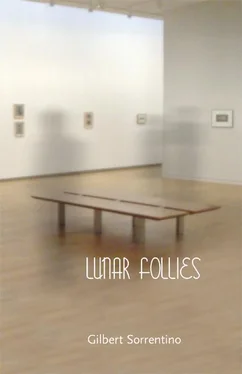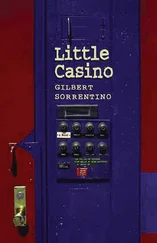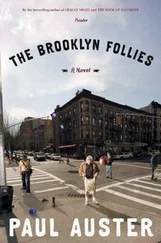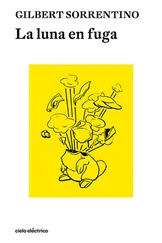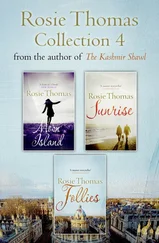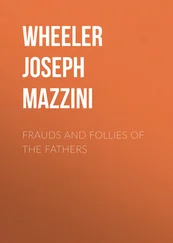The histrionic and lyric firmament — brilliantly spangled with tinsel stars — hangs above the rose-tinted photo-collage of scenes from the Cincinnati Opera Festival’s celebrated production of John Gay’s The Beggar’s Opera. A letter from Jacques Offenbach, attesting to his fondness for Gay’s masterpiece, is quite beautifully yet simply framed in gentian eucalyptus, a wood known for its lustrous qualities and astonishing durability. Jenny Lind sang the wood’s praises in a lost aria from I Puritani, an unjustly neglected operetta by Anna Bolena, performed, for the first and only time, for Henry Ford, Ed Rafferty, and Grover Cleveland Alexander. Scenes from La Gioconda, digitally altered to include portrayals of Brünnhilde in unnatural congress with her stallion, Fritz, temper the dazzling (to some almost painfully so) light from the glowing firmament. Although some Christian Fundamentalist visitors are distressed, even appalled, by the activities of the Wagnerian heroine and her beloved charger, others — happily, the great majority — know that art’s function is to disturb, to question, to disgust, to bore, to nauseate, to make what General Tod Burlingame, Air Force, Retired, called “the big green.” The classic American diner booth, ca. 1949, that asserts its vinyl presence within a shallow alcove at a sudden turning of the wall, is flooded with a penetratingly vulgar orange light, and invites a bittersweet nostalgia in its contrast with the shifting of the erotic tableaux of the La Gioconda display. The whole diner “thing” permits one to recall a purer, more innocent era: of Stalingrad, Iwo Jima, Monte Cassino, Tarawa, Dresden, Hiroshima, and, of course, Auschwitz—“the good old days,” as they are wistfully called. The refreshments — cheeseburgers, French fries, bow ties, Mae Wests, and weak coffee — that crowd the formica-topped table of the diner booth are marvelously crafted of high-impact plastic, and look quite real. At precisely eighteen minutes past the hour, every hour, the pop hit made famous by Andy Warhol and his “gang,” “Bobino Josephine,” in the Boston Pops-Carly Simon version, is piped into the room, an aural complement to the “spectacle” of late-night variety show outtakes. Media critics, as well as their highbrow art-critic cousins, characterize the whole presentation as a profound example of “people’s art.”
New Departures, New Arrivals, Old Masters
The quick wit and twisted imagery of Johnstone Sanderson’s “Nancy” poempix; the unexpurgated love letters, chock full of uninhibited and shimmery filth, of Sanderson William; William MacLise’s generous doses — several in number — of delirious “steel prose”; MacLise Brown’s August ice-cream gouaches, disgustingly compelling; fucking “discourse” and fucking “tropes” and the like, by Brown Forster; the Clitoris Commando Series by the newly notorious, self-styled “Cunt Mama,” Forster John; John Charles’s frothy bubbles (or froth and bubbles) of burgeoning narrative; embedded tautology atop disinterred ontology created in vacuo by Charles Angela, the veteran assemblagist; the sheer vivacity, exuberance, and extravagance of Angela Collins’s “Sheer” portfolio; Collins Anna’s moving photographs of homeless street poets honing their craft; exciting stools of the famous, collected and bronzed by Anna Wilkie of the Atelier de Zotz group; adored meaning, conceived and represented by Wilkie Wendell; Wendell & Warren’s Colorado photos of young people thirsty for art and fun; reconstructions in miniature of charming, friendly, and badly stocked neighborhood bookstores, by Lemon Burdette; Burdette Jones’s glitzy, edgy objects full of elusive racial overtones; a razzberry from el Bronx by Dawn Wasserman’s Gun Hill Road Gang of Gay Girls; Brooklyn boogie, boogie woogie, and woogie wonderland, created by Wasserman Harrison Associates; Harrison Blacke’s little church upon the corner; a cluster of symbolic pens by Blacke White; breathtaking plot-divagation charts, in twenty colors, by White Thorne; distant piles of strangely aloof “stuff” by Thorne Warhol; Warhol Pure’s compelling and really good first book of Berriganesque poetry; the haunting streets of haunting Paris as recreated in West New York, by P.A.P. (Perfect American Products, Inc.).
[A spokeswoman for P.A.P. notes that those who would like to see where “The Haunting Streets” was designed and crafted are welcome to visit the workshop, but she warns that West New York is “actually in New Jersey, which, like, we love it.”]
A large sunlit wall dominates the top floor of the new Iconocult Museum, the much-visited and remarked-upon New York Times Arts & Leisure wall. We see, just inside the south entrance, and to the left, various manifestations, images, and reproductions of duplications, as well as duplicate reproductions that celebrate, among others, Clint Eastwood, Mikhail Baryshnikov, Philip Glass, Jerome Robbins, and — at long last! — the Kronos Quartet, all against a celebrated background of bakhti, rushdie, bezant, and cold-pressed colluvium. This astounding juxtaposition of material and memoir prepares us for the disparate materials on Igor Stravinsky, Wynton Marsalis, Steve Martin, Leonard Bernstein (and the poetry of Carousel and West Side Story), along with a heavily annotated and revised typescript of an essay by Woody Allen on the “poetry of David Mamet’s dialogue” and the lore of the clarinet. Just beyond these joyously eclectic “heapings,” the Public Broadcasting System offers a film of crusty Cornish farmers and their heroic struggles with ovine AIDS, set amid the green hills of Bandore and Deodar. The families, as seen in photographic chronologies, of Steven (“the genius”) Spielberg, Arthur Miller, and Woody (“the shy genius”) Allen, inhabit a quietly hip corner, wherein a subtle democracy of good taste prevails. A film loop of the greatest scenes from Robert Altman’s The Big Sleep plays continuously on the ceiling. On a field of semi-conceptualized phosgene waste are “home-movie” stills of Leonard Bernstein, Sting, and Carly Simon, each of them warmly greeting and entertaining Wynton Marsalis and his New Casa Loma Orchestra, and in one playful image, we see, if we look closely, Leonard Bernstein greeting himself! Next, we encounter a jazz collage, detailing the history of jazz from the days of Buddy Bolden, the New Orleans legend, to giants such as John Coltrane, Miles Davis, Thelonious Monk, and Wynton Marsalis, along with a handful of others who have made jazz America’s music. A consistently interesting section of wall near the jazz exhibit proffers small cards upon which are printed the effusive comments of celebrities of the arts on their relationship to and love of jazz: among them are Marilyn Monroe, Beverly Sills, the managerial team of the Met, the Modern, and the Whitney, Jim Carrey, Leonard Bernstein, and many others, not least of whom is Norman Mailer. Symphony Sid’s ticket stubs for a production of West Side Story are mounted next to a glassine portrait of W. A. Mozart, of whom much too little has been written of late. The short film depicting Paul McCartney sitting for a portrait by Andy Warhol, the Warholian atelier one that is rife with artificial beguines, freshens the palate, so to speak, and the viewer is ready to confront the posters, designed by David Hockney, from an idea by Eddie Murphy, for the new PBS Mystery series, A Dying in Tartonburyshire, a brilliant, dark film based on a novel by E. M. Forster, Howard’s Journey. Anglophilia is also quietly represented by Twyla Tharp’s dance to the music of Leonard Bernstein’s Paris Gypsy, a subtle hommage to Gertrude Stein, Virginia Woolf, and Virgil Thomson. There is, most definitely, a shock in store for the assiduous viewer, as he moves from the staid and classically adventurous to the next exhibit, a brilliant montage of outtakes from the sizzling “underground” film made by Andy Warhol, Jack Smith, and Kenneth Anger, Blond Pussy, starring Anita Ekberg, Diana Dors, and Jayne Mansfield, each of whom plays Marilyn Monroe mimicking Louise Brooks. Lost for years, Pussy must have been a playful romp, one that permits and even encourages art to satirize sex, sex to satirize art, dance to satirize our current moment, and sex to satirize love. In its one screening, it all but silenced the savage gallery of critics at Cannes. Its sole print was purchased by Pablo Picasso, and was last rumored to be in the collection of J. D. Salinger. Speaking of Picasso reminds one, of course, of Henri Matisse, and then, surely, of Roy Lichtenstein: Picasso, Matisse, Lichtenstein — which is greatest, and can we ever know? Miniature reproductions of some of these masters’ representative works go a long way toward helping the viewer to a decision. Representative action figures from a myriad of lead-based nauridium renderings show Picasso and Matisse gazing at the only known photograph — a sepia masterpiece! — of the two canny masters at a baseball game at Chicago’s Wrigley Field. (Photo on loan from the family of Al Capone.) The artists’ Continental mouths are stuffed with a Chicago delicacy, rutabaga sausage, and their eyes are filled with the sadness known only to those who follow the Cubs. Abstract Expressionism is here, too, embodied, so to speak, in an amorphous splash of color, two unevenly matched bilbos, and a 1940 treatise on exology, reputedly an early work by Leonard Bernstein, one that he famously characterized as a “bibelot,” and that became, so rumor has it, the basis for his precedent-shattering Showboat Story. This remark, in and of itself, may possibly be an inside joke by Al Pacino, a quiet balletomane, here shown in a candid photo as “Mister Hollywood, USA,” a refreshing jape, indeed. The New York City Ballet is clustered in a compact haze of sweat, powder, and resin at the far end of the PBS “side” of the wall, catching its collective breath after a thrilling performance of Mozart’s “La Bregmata” (K. 12493776529.7) in a new version by Jerome Robbins, George Balanchine, and Sting, with the assistance of Twyla Tharp and in a “black concerto” orchestration by Wynton Marsalis. It is here that visitors like to rest a moment before going on to the exhibits that feature Carol Burnett, Carol Channing, and Ethel Merman, “geniuses of comedy.” Arthur Miller, George Lucas, and Robert Altman smile from the midst of a massive three-dimensional collage, “The Holocaust: Years of Hope,” that hangs from the Frank Lloyd Wright-inspired ceiling, and that twists, sways, and turns above a series of jagged colporteurs; the sight is, arguably, enough to “make a believer out of just anyone,” as Zubin Mehta, David Mamet, and Leonard Bernstein insist. A creased and somewhat faded snapshot of Herbert Von Karajan, in SS dress blacks, leading a small kazoo band of Hitler Youth in a rendition of “We’ll Meet Again,” for the Führer, has a disturbing sweetness about it, a “boys’ vacation” aura, one that successfully tempers the faux daguerrotype of a thoughtfully scowling Ayn Rand, her Mont Blanc “Aristocrat” pen in one hand and her bailey in the other. A balloon above the famed author-philosopher’s head contains the cryptic message, “WHITHER FREEDOM?” The words become ever more mysterious when we learn from an accompanying wall plaque that they were added to the photograph by J. D. Salinger, when he was but thirteen, and “in thrall,” as a boyhood friend, on condition of anonymity, put it, “to Greta Garbo’s pants.” “Erotica” is the title of the last section of the exhibit, and a video loop, XXXyco, is erratically projected on the ceiling in a series of spasmodic flickerings based upon the orgasmic patterns of “several film stars.” The video, which leaves nothing to the imagination, displays cleverly animated representations of Marilyn Monroe, Virginia Woolf, Igor Stravinsky, and many others, in, as Barbara Kruger’s sublimely and hypnotically monotonous voice intones, “THE UNABASHED ACTION OF TRUE ART.” In the long corridor that leads to the quiet refreshment garden, a dozen lightly clad young women smear themselves with excrement gathered from homeless shelters, and a sign that runs the entire length of the corridor proclaims, in the best seriocomic Krugeresque fashion, SHIT IS NOT CHOCOLATE. The warm bludgers at the garden exit gate are complimentary, and are made, we are told, from a recipe found among the papers of Leonard Bernstein, who may make an appearance on the exhibition’s final day, according to Michael Ovitz and others.
Читать дальше
